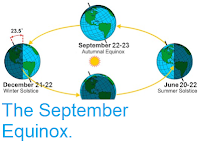The Northern) Solstice falls today (Saturday 21 June 2019), the day on
which the Sun rises highest in the sky and the longest day of the year
in the Northern Hemisphere (where it is the Summer Solstice) and the day
on which the Sun rises lowest in the sky and the shortest day in the
Southern Hemisphere (where it is the Winter Solstice). Up until this
date the days have been growing shorter in the Northern Hemisphere and longer in the Southern Hemisphere since the Southern Solstice in June (which is
the Summer Solstice in the Northern Hemisphere and Winter Solstice in
the Southern Hemisphere), but after it the situation will be reversed,
with days growing steadily longer in the Northern Hemisphere and shorter
in the Southern Hemisphere until the next Southern Solstice in June next year.
The solstices are entirely a product of variation in the Earth's
rotation on its axis, which is at an angle of 23.5° to the plain of the
Earth's orbit about the Sun. This means that in December the Earth's
Southern Pole is tilted towards the Sun, while the Northern Pole is
tilted away from it. This means that around the Southern Solstice the
Southern Hemisphere is receiving radiation from the Sun over a longer
part of the than the Northern, and at a steeper angle (so that it to
pass through less atmosphere to reach the planet), creating the southern
summer and northern winter.
The tilt of the Earth at the Northern Solstice. Wikimedia Commons.
The solstices are fairly noticeable astronomical events, and tied to the seasons which govern the life cycles of life on Earth, and they have been celebrated under different names by cultures across the globe, but most notably by those at higher latitudes, who are more profoundly affected by the changes of the seasons.
See also...







